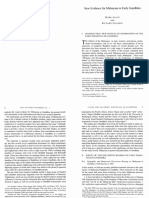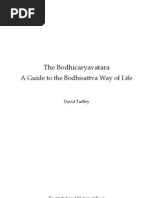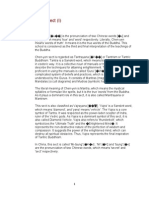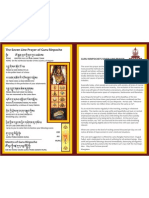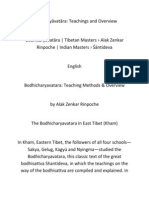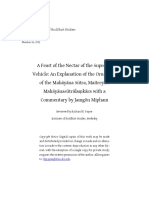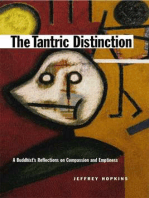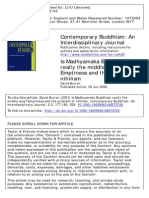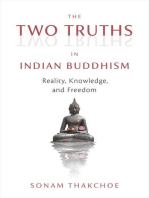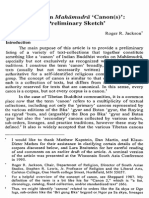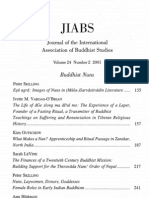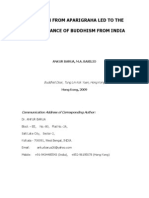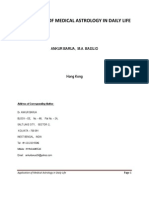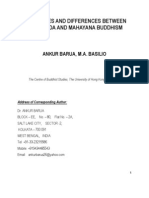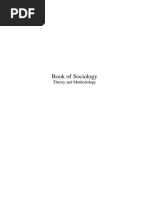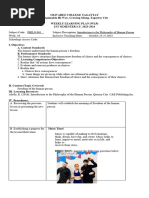Functions of The Eight Kinds of Consciousness in Yogacara
Functions of The Eight Kinds of Consciousness in Yogacara
Uploaded by
ANKUR BARUACopyright:
Available Formats
Functions of The Eight Kinds of Consciousness in Yogacara
Functions of The Eight Kinds of Consciousness in Yogacara
Uploaded by
ANKUR BARUAOriginal Description:
Original Title
Copyright
Available Formats
Share this document
Did you find this document useful?
Is this content inappropriate?
Copyright:
Available Formats
Functions of The Eight Kinds of Consciousness in Yogacara
Functions of The Eight Kinds of Consciousness in Yogacara
Uploaded by
ANKUR BARUACopyright:
Available Formats
FUNCTIONS OF EIGHT KINDS OF
CONSCIOUSNESS IN YOGĀCĀRA
ANKUR BARUA
Introduction
The Yogācāra school of Buddhist thought was founded by the two brothers, Asanga
and Vasubandhu in the fifth century. Origins before this could be traced only through
traditions where Asanga was believed to be mentored by a man known as Maitreya
who might not be historical.1 Yogācāra was already hundreds of years old by the
time of Asanga.2 However, the “foundational scripture” of Yogācāra considered to be
Asanga’s text entitled, “The Scripture on the Explication of Underlying Meaning
(Samdhinirmocanasutra)”.1,3 The original texts of Yogācāra no longer exist in their
original Sanskrit version. But only Chinese and Tibetan translations are available at
present. The gap between the original teachers and the written tradition has
fostered misunderstanding about Yogācāra philosophy.3,4
Evolution of Yogācāra
Yogācāra (yō'gəkär'ə) [Sanskrit = yoga practice], is a philosophical school of
Mahayana Buddhism, also known as the Vijñānavada or Consciousness School.4,5
The founders of this school in India were thought to be Maitreya’s disciple Asanga
(c.375–430) and Asanga's younger half-brother Vasubandhu (c.400–480).5,6 Here, we
Functions of Eight Kinds of Consciousness in Yogācāra Page 1
must remember that though the Maitreya Bodhisatta or Buddha was not a historical
figure, but there is a possibility of historical existence of an Arahant named Maitreya
who is believed to be the teacher of Asanga. If this is true then the historical
Maitreya should be dated during (c.270–350). Vasubandhu also systematized the
Abhidhamma of Buddhist philosophy. Before being introduced to the Yogācāra
philosophy by his brother Asanga, he was a Sautrantika thinker and an expert in
Abhidhamma.4,5,6
The Yogācāra school held that consciousness (vijñāna) is real, but its objects of
constructions are unreal. The school's teachings are thus often characterized by the
phrase “consciousness-only” (citta-matra) or “representation-only” (vijnapti-
matra).6,7
The content of consciousness is produced not by independently existing objects but
by the inner modifications of consciousness itself. A theory of eight kinds of
consciousness was formed to explain how this process functions. The deepest level
of consciousness is the “store-consciousness” (Ālaya-vijñāna), which is both
individual and universal and contains the seeds or traces of past actions, which are
projected into manifestation through the “defiled mind” and the six sense-
consciousnesses (the five physical senses plus mind or thought). The school was
transmitted to China as the Fa-hsiang. It eventually it got synchronized with the
Madhyamika school.7,8,9
Yogācāra: A Reaction to the Concept of Sunyata
Functions of Eight Kinds of Consciousness in Yogācāra Page 2
Yogācāra is influenced by the Prajnaparamita sutras, scriptures of Madhyamaka
Buddhism or the Middle Way. Nagarjuna, the first-known author of Madhyamaka
tradition, taught “sunyata” by upholding the view that emptiness was the ultimate
reality and this insight destroyed all understanding. He rejected all theory and all
philosophy as illusory, believing them to be definitively negated by the dialectic of
emptiness.1 Emptiness or voidness, was intended to mean that the world is “empty
of any imagined creator being or self entity or any notion of an absolute.”1,2,3
Yogācāra is a reaction to the “sunyata” concept. Though Yogācāra is often seen as a
complete break from the doctrine of emptiness and substituting a new idealism in
its place, but this was not the actual intention behind the formation of Yogācāra
school.10 The goal of the first Yogācāra philosophers was to move beyond the limits
of emptiness.9,10 Asanga wanted to “revive” the Nagarjuna and Madhyamaka
philosophy. He wanted to create a strong view of the structure of consciousness
through an investigation into meditation and use it to rethink the notion of
emptiness so that it did not stop with the destruction of all views.1 Vasubandhu
gives his definitive explanation of emptiness in the very beginning of his writing, the
Madhyantavibhaga. In the emptiness or voidness itself, something exists and
persists. This conclusion is not found explicitly in Madhyamaka.10 Yogācāra was also
a response to non-Mahayana schools including Theravada and Sarvastivada.10,11
Significance of Yogācāra
Yogācāra was a synthesis created in response to all existing schools of Buddhism
during the third century BC. Yogācāra extracted the common teachings from all the
Functions of Eight Kinds of Consciousness in Yogācāra Page 3
Buddhist traditions and made an attempt to resolve the problems that most of them
were facing. The key epistemological and metaphysical insights of Yogācāra evolved
from the common Buddhist belief that knowledge comes only from the senses
(vijnapti).4,5,6 With a new insight, Yogācāra proposed that the mind, itself, was an
aspect of vijnapti. Asanga further recognized that though the mind can sense its
own objects, which are known as thoughts (apperception), but it cannot verify its
own interpretation. As the senses are constantly misinterpreted, our thoughts
(apperceptions) are also misinterpreted in the same way. These misconceptions are
instinctive and nearly universal because they are caused by the desires, fears and
anxieties that come with animal survival. This results in an automatic assumption of
substance for self and objects (atman and dharma) which are created to suppress
our fears.4,6
Yogācāra departs from the common Buddhist understanding not only in its view of
the problem, but also in its view of the solution. We cannot perceive correctly the
perception that we do not perceive reality correctly. So, we never can actually verify
our apperception with perfect accuracy.4,6 Yogācāra talks about “grasper/grasped”
rather than “subject/object” respectively and also introduces a causal relationship.
We grasp because we desire; desire comes from a sense of need. What we
fundamentally lack is a self, thus we seek to preserve what we do not have.
Because we strive to survive, we do not naturally challenge the assumption of our
own being. The solution is to disown the phenomena within our minds as our own.
Sensations of pleasure and pain, belief, ignorance, language and reason are the
strategies employed to preserve the self which come at the expense of our
unending sense of need.4,6
Functions of Eight Kinds of Consciousness in Yogācāra Page 4
Various Types of Consciousness in Yogācāra
The most famous innovation of the Yogācāra School was the doctrine of eight
consciousnesses. Early Buddhism and Abhidhamma described six consciousnesses,
each produced by the contact between its specific sense organ and a corresponding
sense object. Thus, when a functioning eye comes into contact with a color or
shape, visual consciousness is produced. Consciousness does not create the
sensory sphere, but is an effect of the interaction of a sense organ and its true
object. If an eye does not function but an object is present, visual consciousness
does not arise. The same is true if a functional eye fails to encounter a visual
object.10,11,12
Arising of consciousness is dependent on sensation. There are altogether six sense
organs (eye, ear, nose, mouth, body, and mind) which interact with their respective
sensory object domains like visual, auditory, olfactory, gustatory, tactile, and
mental spheres. Here, the mind is considered to be another sense organ as it
functions like the other senses. It involves the activity of a sense organ (manas), its
domain (mano-dhātu) and the resulting consciousness (mano-vijñāna). Each domain
is discrete and function independent of the other. Hence, the deaf can see and the
blind can hear. Objects are also specific to their domain and the same is true of the
consciousnesses like the visual consciousness is entirely distinct from auditory
consciousness. There are six distinct types of consciousness namely, the visual,
auditory, olfactory, gustatory, tactile and mental consciousness. The six sense
organs, six sense object domains and six resulting consciousnesses comprise our
Functions of Eight Kinds of Consciousness in Yogācāra Page 5
eighteen components of experience and are known as the eighteen dhātus.
According to Buddhism, these eighteen dhātus are the comprehensive sensorium of
everything in the universe. 10,11,12,13
As Abhidhamma grew more complex, disputes intensified between different
Buddhist schools along a range of issues. In order to avoid the idea of a permanent
self, Buddhists said citta is momentary. Since a new citta apperceives a new
cognitive field each moment, the apparent continuity of mental states was
explained causally by claiming each citta, in the moment it ceased, also acted as
cause for the arising of its successor. This was fine for continuous perceptions and
thought processes, but difficulties arose since Buddhists identified a number of
situations in which no citta at all was present or operative, such as deep sleep,
unconsciousness, and certain meditative conditions explicitly defined as devoid of
citta (āsaṃjñī-samāpatti, nirodha-samāpatti). So, the controversial questions were:
from where does consciousness reemerge after deep sleep? How does
consciousness begin in a new life? The various Buddhist attempts to answer these
questions led to more difficulties and disputes. For Yogācāra the most important
problems revolved around questions of causality and consciousness.10,11,12,13
Yogācārins responded by rearranging the tripartite structure of the mental level of
the eighteen dhātus into three novel types of consciousnesses. Mano-vijñāna
(empirical consciousness) became the sixth consciousness processing the cognitive
content of the five senses as well as mental objects (thoughts, ideas). Manas
became the seventh consciousness, which was primarily obsessed with various
aspects and notions of "self". Hence, it was called "defiled manas" (kliṣṭa-manas).
Functions of Eight Kinds of Consciousness in Yogācāra Page 6
The eighth consciousness, ālaya-vijñāna also known as "warehouse consciousness,"
10,11,12,13,14
was totally novel.
Functions of Eight Kinds of Consciousness in Yogācāra Page 7
Understanding our mind—Eight kinds of consciousness and their
functions11,12,14
Transformatio Functions of Comparison with
The Eight Kinds
n into four the Computer
of these Eight
types of Data Processing
Consciousness Consciousnesses
Wisdom System
First five
consciousnesse Data Collection
s- Centre:
1. eye - visual
2. ear - auditory Wisdom of
Windows to the
Successful Raw Data Input
3. nose - external world or
Performance
olfactory contact with the
external
4. tongue - environment to
gustatory collect information
5. body - tactile
Sense Centre:
Data Processing:
Sixth or Mind Wisdom of
consciousness The CPU (central
Wonderful
Performing the processing unit)
Contemplatio
functions of
6. Mind n
cognition and
differentiation Forming conceptions
out of perceptions.
Seventh Wisdom of Thought Centre:
consciousness Equality
Data analysis
Plays the role of
Manas thinking on a self-
consciousness centered basis. As the result of ‘self-
centered’ situation,
all the selfish
thoughts, egotistic
opinion, arrogance,
Functions of Eight Kinds of Consciousness in Yogācāra Page 8
self-love, etc. would
arise.
Eighth
Store Centre Data Storage
consciousness
(store-house):
Grand-round-
Ālaya mirror-like Each seed has
consciousness Wisdom The new seeds are infinite power to
perfumed from time produce a
to time manifestation.
The Eighth Consciousness (Ālaya Consciousness) 11,12,13,14
Warehouse Consciousness was defined as the receptacle of all seeds, storing
experiences as they "enter" until they are sent back out as new experiences. This is
the same way as a warehouse handles inventories. It was also called vipāka
consciousness, where vipāka means the "maturing" of karmic seeds. Seeds
gradually matured in the repository consciousness until karmically ripe and can
reassert themselves as karmic consequences. Ālaya -vijñāna was also called the
"basic consciousness" (mūla-vijñāna) as it retains the karmic seeds that both
influence and are influenced by the other seven consciousnesses. For example,
when the sixth consciousness is dormant (while one sleeps, or is unconscious), its
seeds reside in the eighth consciousness. They "restart" when the conditions for
their arising are present. The eighth consciousness is a mechanism for storing and
deploying seeds of which it remains unaware. The Warehouse Consciousness acts as
the pivotal karmic mechanism, but is itself karmically neutral. Each individual has its
own Warehouse Consciousness which is nothing more than a collection of ever-
Functions of Eight Kinds of Consciousness in Yogācāra Page 9
changing "seeds." It is continuously changing and therefore not a permanent self.
So, there is no universal collective mind in Yogācāra.
Four Wisdoms from Eight Consciousnesses10,11,12,13,14
(1) The first five perceptual consciousnesses are transformed into the Wisdom of
Successful Performance. This wisdom is characterized by pure and unimpeded
functioning (no attachment or distortion) in its relation to the (sense) organs and
their objects.
(2) The sixth consciousness is the perceptual and cognitive processing center. It is
transformed into the Wisdom of Wonderful Contemplation which has two aspects
corresponding to understanding of the “emptiness of self” and that of the
“emptiness of dharmas”.
(3) The seventh consciousness defiles the first six consciousnesses with self and
self-related afflictions. It is transformed into the Wisdom of Equality which
understands the nature of the equality of self and of all other beings.
(4) The eighth, the storehouse consciousness, is transformed into the grand-mirror-
like wisdom. This wisdom reflects the entire universe without distortion. Like
mirror can reflect many objects simultaneously, the wisdom can perceive many
objects accurately and simultaneously. This can be achieved by proper
transformation of the Ālaya-vijñāna to this wisdom and is considered to be the
state of the Buddhahood.
Functions of Eight Kinds of Consciousness in Yogācāra Page 10
Conclusion
In Yogācāra concept, true knowledge begins when consciousness ends. Thus,
“Enlightenment” is considered as the act of bringing the eight consciousnesses to
an end and replacing them with enlightened cognitive abilities (jñāna). Here, the
sixth consciousness (Manas) becomes the immediate cognition of equality (samatā-
jñāna) by equalizing self and other. When the Warehouse Consciousness finally
ceases it is replaced by the Great Mirror Cognition (Mahādarśa-jñāna) that sees and
reflects things truly as they are (yathā-bhūtam).8,9,11,14 Thus, the grasper-grasped
relationship ceases and the mind projects the things impartially without exclusion,
prejudice, anticipation, attachment, or distortion. These "purified" cognitions
remove the self-bias, prejudice and obstructions that had previously prevented a
person from perceiving beyond his selfish consciousness. Since enlightened
cognition is non-conceptual, its objects cannot be described. So, the Yogācāra
school could not provide any description regarding the outcome of these types of
enlightened cognitions except for referring these as 'pure' (of imaginative
constructions). There was also another Yogācāra innovation in the field of
consciousness. This was the notion that a special type of cognition can emerge and
develop after the attainment of enlightenment. This post-enlightenment cognition
was called “pṛṣṭhalabdha-jñāna”. It is concerned with how and Enlightened One can
engage himself in assisting other sentient beings in overcoming the suffering and
ignorance. 6,8,11,13,14
Though, in simple terms, Yogācāra means, “the school that practices the way of
yoga,”2 but the practical methodology of yogic meditation merely reveals the
Functions of Eight Kinds of Consciousness in Yogācāra Page 11
meaning of the underline philosophy. Insight meditation is actually a means of
abandoning delusions about the self and about the world. The original teachings
reveal the insights of Yogācāra and represent the greatest philosophical
achievement of the east, which surpasses the accomplishments of Western
philosophy.14 So, a great deal of understanding is required if we want to completely
understand and assimilate the inner concepts of Yogācāra.
Functions of Eight Kinds of Consciousness in Yogācāra Page 12
References
1. Keenan, J.P. 1993. Yogācāra in Buddhist Spirituality. Indian, Southeast Asian,
Tibetan and Early Chinese, eds. Yoshinori, Takeuchi, et al. World Spirituality: An
Encyclopedic History of the Religious Quest. New York: Crossroad 8:203-12.
2. Koller, J.M., Koller, P. 1991. A Sourcebook in Asian Philosophy. Upper Saddle
River, NJ: Prentice Hall: 306.
3. Radhakrishman, S., Moore, C.A. 1957. A Sourcebook in Indian Philosophy. Ewing,
NJ: Princeton University Press.
4. Keenan, J.P. 1988. Buddhist Yogācāra Philosophy as Ancilla Theologiae. Japanese
Religions 15: 36.
5. Pensgard, D. 2006. Yogācāra Buddhism: A sympathetic description and
suggestion for use in Western theology and philosophy of religion. JSRI 15:94-
103.
6. Lusthaus, D. 2002. Buddhist Phenomenology: A Philosophical Investigation of
Yogācāra Buddhism and the Ch’eng Wei-shih lun. New York: Routledge Curzon.
7. Suzuki, D.T. 1998. Studies in the Lankavatara Sutra. New Delhi: India Munshiram
Manoharlal Pub Pvt Ltd.
8. Chatterjee, A.K. 1975. The Yogācāra Idealism. Varnasi, India: Bhargava Bhushan
Press, the Banaras Hindu University Press.
9. Tripathi, C.L.1972. The Problem of Knowledge in Yogācāra Buddhism. Varnasi,
India: Bharat-Bharati Press.
10.King, R.1994. Early Yogācāra and its relationship with the Madhyamika school.
Philosophy East & West 44: 659.
Functions of Eight Kinds of Consciousness in Yogācāra Page 13
11.King, R. 1998. Vijnaptimatrata and the Abhidhamma context of early Yogācāra.
Asian Philosophy 8(1): 5.
12.Yin, J. 2009. Yogācāra school and Faxiang school. Hong Kong: The Centre of
Buddhist Studies, the University of Hong Kong.
13.Larrabee, M. J. 1981. The One and the Many: Yogācāra Buddhism and Husserl.
Philosophy East & West 31: 3-15.
14.Wayman, A. 1996. A defense of Yogācāra Buddhism. Philosophy East & West
46(4): 447.
Functions of Eight Kinds of Consciousness in Yogācāra Page 14
You might also like
- Waldron William - How Innovative Is The Alayavijnana (JIP 94) PDFDocument60 pagesWaldron William - How Innovative Is The Alayavijnana (JIP 94) PDFJuan RestrepoNo ratings yet
- Did The Buddha Impart An Esoteric Teaching (Clearscan)Document18 pagesDid The Buddha Impart An Esoteric Teaching (Clearscan)Guhyaprajñāmitra30% (1)
- Aspects of Spiritual Practice in Early YogacaraDocument33 pagesAspects of Spiritual Practice in Early YogacaraGuhyaprajñāmitra3No ratings yet
- The Concept of Applied BuddhismDocument4 pagesThe Concept of Applied BuddhismANKUR BARUA100% (1)
- Week 3 PPT Ucsp 12Document35 pagesWeek 3 PPT Ucsp 12Jella Secreto100% (5)
- NSTP ReviewerDocument13 pagesNSTP ReviewerKimberlee Descatamiento100% (2)
- YogacaraDocument12 pagesYogacaracherryflakesNo ratings yet
- Salomon R. Allon M.-New Evidence For Mahayana in Early GandharaDocument12 pagesSalomon R. Allon M.-New Evidence For Mahayana in Early Gandharashu_sNo ratings yet
- BodhisattvacaryāvatāraDocument10 pagesBodhisattvacaryāvatāraLiu Fengshui100% (1)
- Chen YenDocument16 pagesChen Yenmonkist100% (1)
- Guru Rinpoceh Seven Line Prayer - Front and Back MASTERDocument1 pageGuru Rinpoceh Seven Line Prayer - Front and Back MASTERRon Franklin100% (1)
- TRALEG KYABGON - The-Influence-of-Yogacara-on-Mahamudra PDFDocument145 pagesTRALEG KYABGON - The-Influence-of-Yogacara-on-Mahamudra PDFFilippo Lunardo100% (1)
- Kochumuttom - A Buddhist Doctrine of Experience - A New Translation and Interpretation of The Works of Vasubandhu The YoDocument313 pagesKochumuttom - A Buddhist Doctrine of Experience - A New Translation and Interpretation of The Works of Vasubandhu The Yodanielsaldanha100% (1)
- Teachings On The BodhicaryāvatāraDocument29 pagesTeachings On The Bodhicaryāvatāraphoenix1220No ratings yet
- Jamyang Shepa Ngawang Tsondru Root Verses On Indian PhilosophiesDocument33 pagesJamyang Shepa Ngawang Tsondru Root Verses On Indian PhilosophiesBLhundrupNo ratings yet
- Parallels in Engineering and Humanistic Buddhism - by Winie WongDocument7 pagesParallels in Engineering and Humanistic Buddhism - by Winie WongLow Beng KiatNo ratings yet
- Buddhism and Western PsychologyDocument49 pagesBuddhism and Western PsychologyHoang NguyenNo ratings yet
- Sounds of Innate Freedom: The Indian Texts of Mahamudra, Volume 3From EverandSounds of Innate Freedom: The Indian Texts of Mahamudra, Volume 3No ratings yet
- What The Nikayas Say About NibbanaDocument34 pagesWhat The Nikayas Say About Nibbanamichaelnyman9999100% (4)
- Buddha Nature and The Indivisibility of The Two TruthsDocument13 pagesBuddha Nature and The Indivisibility of The Two TruthsKathodhraNo ratings yet
- What Changes and What Doesn't An Interview With Dzongsar Khyentse RinpocheDocument3 pagesWhat Changes and What Doesn't An Interview With Dzongsar Khyentse RinpocheDtng FcbkNo ratings yet
- The Thirty Verses of VasubandhuDocument26 pagesThe Thirty Verses of VasubandhuMeiunNo ratings yet
- The 4 Schools of Buddhist Philosophy by Elías Capriles (Again Available)Document330 pagesThe 4 Schools of Buddhist Philosophy by Elías Capriles (Again Available)clararrosamar100% (2)
- Vdocuments - MX The Words of My Perfect Teacher by Dzongsar Jamyang Khyentse Rinpoche SanDocument73 pagesVdocuments - MX The Words of My Perfect Teacher by Dzongsar Jamyang Khyentse Rinpoche SanTempa Jikme100% (1)
- Evil in BuddhismDocument14 pagesEvil in BuddhismFederico DrasalNo ratings yet
- Hevajra Tantra WikiDocument5 pagesHevajra Tantra WikiCarlos GreeneNo ratings yet
- Newtown School TragedyDocument3 pagesNewtown School TragedyCharles DayNo ratings yet
- Arindam Chakrabarty (2011) Troubles With A Second Self The Problem of Other Minds in 11th Century Indian and 20th Century Western Philosophy PDFDocument13 pagesArindam Chakrabarty (2011) Troubles With A Second Self The Problem of Other Minds in 11th Century Indian and 20th Century Western Philosophy PDFAmitranjan BasuNo ratings yet
- 210 221 - Payne - A Feast of The Nectar of The Supreme VehicleDocument14 pages210 221 - Payne - A Feast of The Nectar of The Supreme VehicleFred FrogNo ratings yet
- Sutra Copying Manual PreviewDocument6 pagesSutra Copying Manual PreviewKev0192No ratings yet
- Khenpo Tsultrim Gyamtso Rinpoche & Thogme Zangpo - The 37 Practices of A BodhisattvaDocument32 pagesKhenpo Tsultrim Gyamtso Rinpoche & Thogme Zangpo - The 37 Practices of A Bodhisattvadaniele100% (1)
- Masters of Meditation and Miracles: Lives of the Great Buddhist Masters of India and TibetFrom EverandMasters of Meditation and Miracles: Lives of the Great Buddhist Masters of India and TibetRating: 4.5 out of 5 stars4.5/5 (3)
- Heart Advicefor Practicing Dharmain Daily LifeDocument9 pagesHeart Advicefor Practicing Dharmain Daily Lifevivekgandhi7k7No ratings yet
- Adam Warcup - An Inquiry Into The Nature of MindDocument22 pagesAdam Warcup - An Inquiry Into The Nature of Minddoggy7No ratings yet
- The Broken World of Sacrifice: An Essay in Ancient Indian RitualFrom EverandThe Broken World of Sacrifice: An Essay in Ancient Indian RitualNo ratings yet
- Ahimsa in BuddhismDocument13 pagesAhimsa in BuddhismvasubandhuNo ratings yet
- KI PathAndGrounds Delighting DrapaSedrupDocument38 pagesKI PathAndGrounds Delighting DrapaSedrupjiashengroxNo ratings yet
- The Power of Meditation: A Complete Guide to Transforming Your MindFrom EverandThe Power of Meditation: A Complete Guide to Transforming Your MindNo ratings yet
- 3 Principle Aspects of The Path by Jeffery HopkinsDocument2 pages3 Principle Aspects of The Path by Jeffery HopkinsPhilip Rodgers100% (1)
- Paticcasamuppada Buddhadasa Bhikkku - SconosciutoDocument125 pagesPaticcasamuppada Buddhadasa Bhikkku - Sconosciutonicheloro100% (2)
- The Tantric Distinction: A Buddhist's Reflections on Compassion and EmptinessFrom EverandThe Tantric Distinction: A Buddhist's Reflections on Compassion and EmptinessNo ratings yet
- Burton, David - Is Madhyamaka Buddhism Really The Middle Way? Emptiness and The Problem of Nihilism - (Contemporary Buddhism - An Interdisciplinary Journal) - Vol 2 - No 2 - 2008Document16 pagesBurton, David - Is Madhyamaka Buddhism Really The Middle Way? Emptiness and The Problem of Nihilism - (Contemporary Buddhism - An Interdisciplinary Journal) - Vol 2 - No 2 - 2008Nick DahlheimNo ratings yet
- Choosing Compassion: How to Be of Benefit in a World That Needs Our LoveFrom EverandChoosing Compassion: How to Be of Benefit in a World That Needs Our LoveNo ratings yet
- BodhisDeedsComm GJTegchok Nalanda1993-EdSept05Document463 pagesBodhisDeedsComm GJTegchok Nalanda1993-EdSept05Lars SchievingNo ratings yet
- Immeasurables PrayerDocument2 pagesImmeasurables PrayerGLarsonNo ratings yet
- Introduction To The Middle Way - OdtDocument6 pagesIntroduction To The Middle Way - OdtJaume Estelles LevinasNo ratings yet
- rgyud sde kun btus目录Document53 pagesrgyud sde kun btus目录Dayuer YangNo ratings yet
- Complete Nyingma Tradition From Sutra To Tobden Dorje 0 Gyurme Dorje 0 Lama TharchinDocument3 pagesComplete Nyingma Tradition From Sutra To Tobden Dorje 0 Gyurme Dorje 0 Lama TharchinDoron SabariNo ratings yet
- 1.1 NagarjunaDocument8 pages1.1 Nagarjunaallandzx100% (1)
- 01 Early BuddhismDocument9 pages01 Early BuddhismAshin TejobhasaNo ratings yet
- Acarya Dharma Vajra - Madhyamika Buddhism Vis-A-Vis Hindu VedantaDocument8 pagesAcarya Dharma Vajra - Madhyamika Buddhism Vis-A-Vis Hindu VedantaKavi-Karnapura DasaNo ratings yet
- Vedanta Vis A Vis ShentongDocument5 pagesVedanta Vis A Vis ShentongIshwor Cvs ShresthaNo ratings yet
- The Two Truths in Indian Buddhism: Reality, Knowledge, and FreedomFrom EverandThe Two Truths in Indian Buddhism: Reality, Knowledge, and FreedomNo ratings yet
- Roger R Jackson The Indian Mahamudra Canons A Preliminary SketchDocument34 pagesRoger R Jackson The Indian Mahamudra Canons A Preliminary SketchJustin von Bujdoss100% (1)
- Mipham Rinpoche & Sangpo RinpocheDocument50 pagesMipham Rinpoche & Sangpo Rinpocheklhundrupd100% (1)
- Nibbana For EveryoneDocument3 pagesNibbana For Everyonegreenboy50% (2)
- Wisdom Publications Spring 2010Document24 pagesWisdom Publications Spring 2010Amina Marix Evans100% (2)
- Jiabs 24-2Document171 pagesJiabs 24-2JIABSonline50% (2)
- Smith, Frederick. The Fulcrum of Experience in Indian Yoga and Possession TranceDocument16 pagesSmith, Frederick. The Fulcrum of Experience in Indian Yoga and Possession Trancevkas100% (1)
- Ciaspolate Valseriana ValgoglioDocument25 pagesCiaspolate Valseriana ValgoglioAndreasJauchMeyrinchNo ratings yet
- Methods For Setting Cut Scors in Criterion-Referenced InstrumentsDocument170 pagesMethods For Setting Cut Scors in Criterion-Referenced InstrumentsANKUR BARUANo ratings yet
- Indian Union Budget 2011Document4 pagesIndian Union Budget 2011ANKUR BARUANo ratings yet
- Mathematical Background For Mathematical EpidemiologyDocument179 pagesMathematical Background For Mathematical EpidemiologyANKUR BARUANo ratings yet
- Applied Buddhism in Self CultivationDocument61 pagesApplied Buddhism in Self CultivationANKUR BARUA100% (1)
- Vancouver Style of ReferencingDocument1 pageVancouver Style of ReferencingANKUR BARUANo ratings yet
- Develop Mirror-Like WisdomDocument11 pagesDevelop Mirror-Like WisdomANKUR BARUA100% (2)
- Applied Buddhism in Prevention of Global Economic CrisisDocument18 pagesApplied Buddhism in Prevention of Global Economic CrisisANKUR BARUANo ratings yet
- Applied Buddhism - The Foundation of Our True UnderstandingDocument10 pagesApplied Buddhism - The Foundation of Our True UnderstandingANKUR BARUANo ratings yet
- Deviation From Aparigraha Led To The Disappearance of Buddhism From IndiaDocument8 pagesDeviation From Aparigraha Led To The Disappearance of Buddhism From IndiaANKUR BARUANo ratings yet
- The Concept of Emptiness of Matter in Modern ScienceDocument8 pagesThe Concept of Emptiness of Matter in Modern ScienceANKUR BARUANo ratings yet
- Pali For BeginnersDocument33 pagesPali For BeginnersANKUR BARUA100% (1)
- Buddhist Approach To Protect The Environment in Perspective of Green Buddhism.Document13 pagesBuddhist Approach To Protect The Environment in Perspective of Green Buddhism.Rudy SusantoNo ratings yet
- The Bodhisatta Concept in Theravada BuddhismDocument20 pagesThe Bodhisatta Concept in Theravada BuddhismANKUR BARUA100% (3)
- Application of Medical Astrology in Daily LifeDocument6 pagesApplication of Medical Astrology in Daily LifeANKUR BARUA50% (2)
- Disappearance of Buddhism From India - The Role of ShashankaDocument8 pagesDisappearance of Buddhism From India - The Role of ShashankaANKUR BARUA100% (1)
- Curriculum Vitae of Dr. Ankur BaruaDocument38 pagesCurriculum Vitae of Dr. Ankur BaruaANKUR BARUA100% (1)
- Deification of The BuddhaDocument27 pagesDeification of The BuddhaANKUR BARUANo ratings yet
- Similarities and Differences Between Theravada and Mahayana BuddhismDocument10 pagesSimilarities and Differences Between Theravada and Mahayana BuddhismANKUR BARUA89% (9)
- Book of SociologyDocument284 pagesBook of SociologyAamir Mushtaq CheemaNo ratings yet
- Group 4 - Reference and SenseDocument24 pagesGroup 4 - Reference and SenseMachsunaNo ratings yet
- Masooma, Muskan, Dua and Lubaba: Prepared byDocument9 pagesMasooma, Muskan, Dua and Lubaba: Prepared byMasooma AlíNo ratings yet
- Art Art Has Been Considered The Sole Responsible For The Destruction of Moral Values and Source of Infection in Human Life by Plato and Tolstoi RespectivelyDocument2 pagesArt Art Has Been Considered The Sole Responsible For The Destruction of Moral Values and Source of Infection in Human Life by Plato and Tolstoi RespectivelyAmir SakhawatNo ratings yet
- Universalist Grandeur, Romantic Depth, Pragmatist Cunning Richard RortyDocument13 pagesUniversalist Grandeur, Romantic Depth, Pragmatist Cunning Richard Rortyrustycarmelina108100% (1)
- Contemporary Philippine Arts From TheDocument21 pagesContemporary Philippine Arts From TheJowee Anne BagonNo ratings yet
- What Is Useful? The Paradox of Rights in Tania Bruguera's Useful Art'Document4 pagesWhat Is Useful? The Paradox of Rights in Tania Bruguera's Useful Art'Cayo HonoratoNo ratings yet
- Freedom, Morality, and GraceDocument26 pagesFreedom, Morality, and GraceHaechan LEENo ratings yet
- Free WillDocument3 pagesFree Willapi-260900514No ratings yet
- CODE OF ETHICS For Teachers SummaryDocument2 pagesCODE OF ETHICS For Teachers SummaryEmerlyn Charlotte FonteNo ratings yet
- Understanding PowerDocument37 pagesUnderstanding PowerRamjit Kumar100% (1)
- Legal Positivism Human RightsDocument5 pagesLegal Positivism Human RightsAlok KumarNo ratings yet
- Objectivism and TheismDocument68 pagesObjectivism and TheismakimelNo ratings yet
- Introduction To Lawrence VenutiDocument16 pagesIntroduction To Lawrence VenutiLalannNo ratings yet
- Basic Philosophy of EducationDocument2 pagesBasic Philosophy of EducationDj22 JakeNo ratings yet
- Handouts 2Document2 pagesHandouts 2Analyn FabianNo ratings yet
- Chapter 5 Business EthicsDocument9 pagesChapter 5 Business EthicsRommel LayosaNo ratings yet
- Philosophy of Life (Philosophy 101, SUNY Cobleskill)Document4 pagesPhilosophy of Life (Philosophy 101, SUNY Cobleskill)Ben KaiserNo ratings yet
- SN 12.2 - Vibhaṅgasutta-Bhikkhu SujatoDocument3 pagesSN 12.2 - Vibhaṅgasutta-Bhikkhu SujatoRyan BurtonNo ratings yet
- Manaiz, Lea Maxine A. (DISS Act 1 & 2)Document9 pagesManaiz, Lea Maxine A. (DISS Act 1 & 2)LEA MAXINE MANAIZNo ratings yet
- ''It Is by Doubting That We Come To Investigate, and by Investigating That We Recognize The Truth"Document9 pages''It Is by Doubting That We Come To Investigate, and by Investigating That We Recognize The Truth"Eduardo BonillaNo ratings yet
- The Moral Case For Sexbots: Review Article Marc BehrendtDocument20 pagesThe Moral Case For Sexbots: Review Article Marc BehrendtSAJID OLVERANo ratings yet
- GE1 Module 5 Eastern Western ThoughtDocument5 pagesGE1 Module 5 Eastern Western ThoughtMyoui MinaNo ratings yet
- Spiritual Motivational Theory and Love and Affection Motivation TheoryDocument8 pagesSpiritual Motivational Theory and Love and Affection Motivation Theorysrabon ahmedNo ratings yet
- Ken Wilber and AQAL Integral All Quadrant All Level ThinkingDocument46 pagesKen Wilber and AQAL Integral All Quadrant All Level ThinkingJonas George S. SorianoNo ratings yet
- Wlp-W10-Philo 001Document6 pagesWlp-W10-Philo 001John Lester CubileNo ratings yet
- Structuralism and Functionalism Schools of ThoughtDocument3 pagesStructuralism and Functionalism Schools of ThoughtAbrar AhmadNo ratings yet
- Konstantinos Georgiadis, Th.D. Religion and Law Teacher/ Greek Secondary EducationDocument2 pagesKonstantinos Georgiadis, Th.D. Religion and Law Teacher/ Greek Secondary EducationPablo CanovasNo ratings yet







